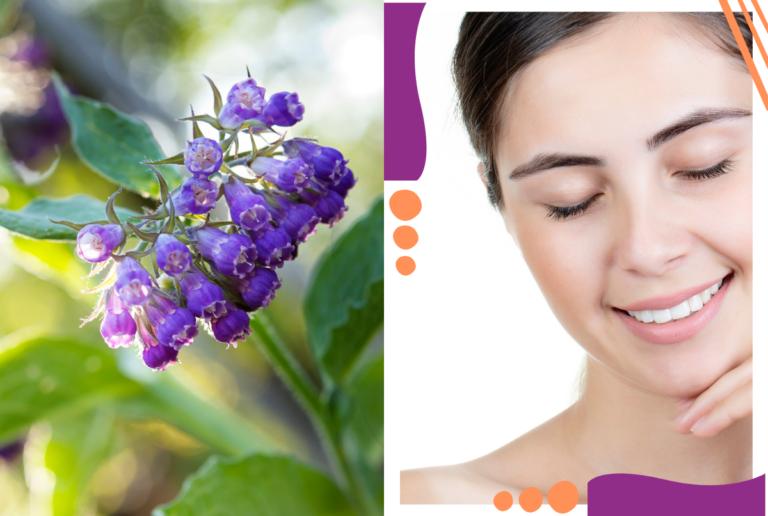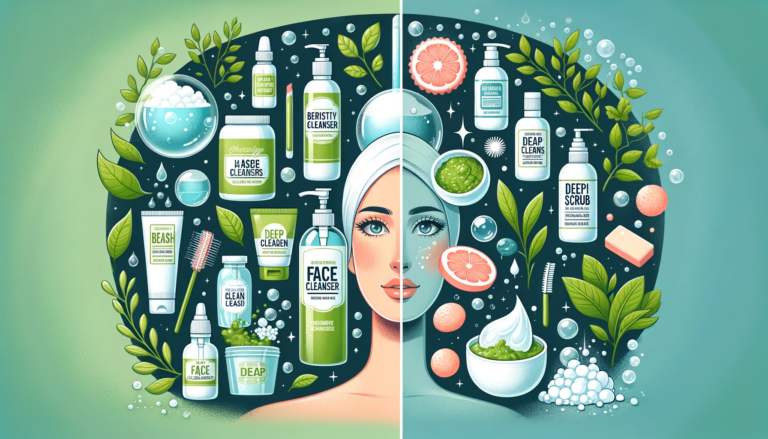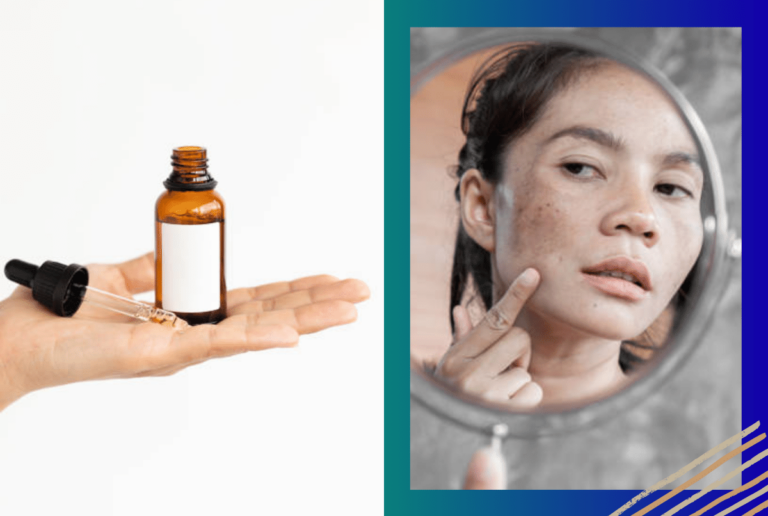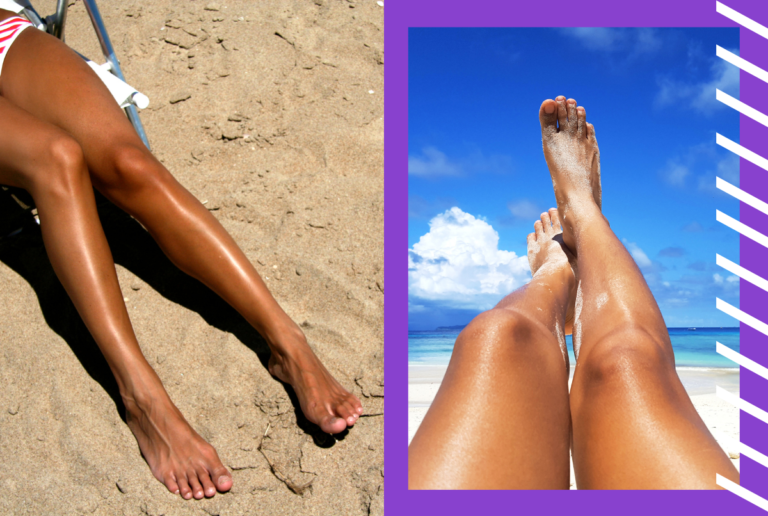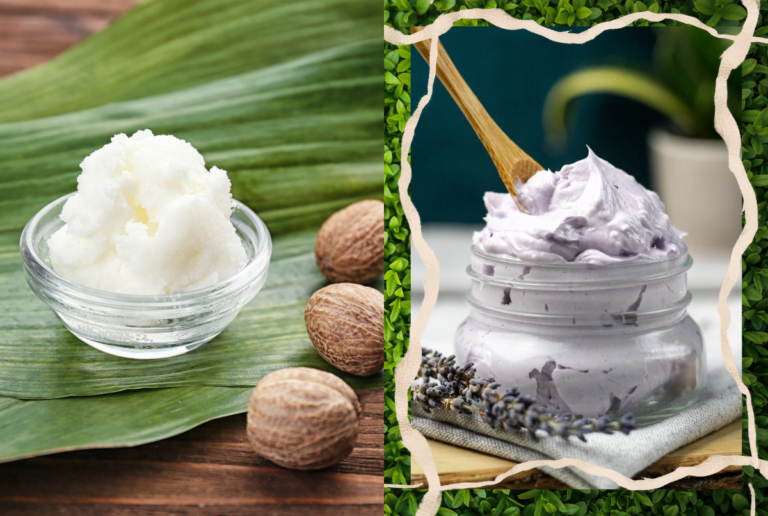Yellow Shea Butter Vs. White Shea Butter
A good skincare routine is all you need to keep your skin healthy and glowing. But choosing the right skin care product is equally important.
And when we talk about suitable skincare products, shea butter has a rich history. People have used shea butter for centuries to rejuvenate their skin owing to its high nutrient content. It has a pretty high cosmetic value, whether as a moisturizer or a lotion.
On top of that, the quality of shea butter has developed tremendously over the years. And with the abundance of so many good shea butter products, choosing the best shea butter can be a bit overwhelming.
Usually, there are two primary choices, yellow or white shea butter. And that’s why we’re here to talk all about these two types of shea butter to lend you a helping hand.
So, without further ado, let’s get on with it!
What Is Shea Butter?
Before we go into discussing the details regarding white and yellow shea butter, let’s answer the most burning question of what shea butter exactly is. To answer simply, it is essentially a seed fat coming from the African shea tree. So, the oily kernels[1] of the seeds are the key ingredients for preparing shea butter.
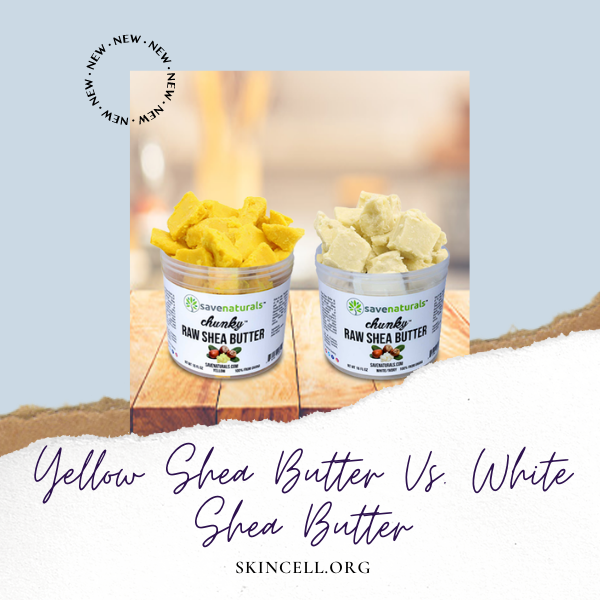
The kernels make the cosmetic ingredient rich in vitamins and fatty acids, perfect for nourishing even the driest and most dehydrated skin. Thus, people have been using shea butter to moisturize and smoothen their skin for centuries.
What’s more, you can also use it as a salve to protect and heal your skin from nasty cuts and burns. Apart from its benefits as a beauty product, the fat from the shea butter is also used for cooking. But shea butter is widely popular as a cosmetic product when it comes to manufacturing.
What Are The Benefits Of Using Shea Butter?
1. For Your Skin
The most widely known benefit of applying shea butter on your skin is moisturizing and hydrating your skin cells. It also contains fatty acids and necessary vitamins to heal and rejuvenate damaged skin. Hence, the high nutritional value of shea butter makes it an excellent cosmetic ingredient for your skin.
What’s more, high-quality shea butter has anti-inflammatory and antioxidant properties that enhance blood flow and reduce fat deposition in your skin cells. Shea butter also helps in boosting collagen production to make your skin look healthy and young. So, it reduces wrinkles and fine lines to restore the youthful glow of your skin.
2. For Your Hair
Although it’s a lesser-known fact, you can use shea butter to stimulate hair growth and reduce hair loss. It can also be used to fight dandruff and dry scalp problems. You can apply it as a hair mask to nourish your hair and make it look lush and beautiful. Hence, shea butter is massively beneficial in repairing your damaged hair follicles.
Not only that, but you can also use shea butter as a hair conditioner. It is rich in hydrating ingredients that can deeply nourish and moisturize the hair roots. So, it can help your hair look smooth and shiny. Furthermore, shea butter helps improve dry hair like coconut oil. Its high nutrient content also helps in conditioning damaged hair.
Shea Butter Processing
As we mentioned in the previous section, shea butter is extracted from the seeds of the shea tree. The seeds are first dried to take out their oily kernels. After removing the kernels, they are roasted and ground into a fine powder. The roasting offers a smoky smell to the shea butter.
Once the kernels are roasted and ground, they are boiled in water. After boiling the roasted, powdered seeds for a while, the butter floats up to the surface. It is gently scooped off and left to solidify before using.
Now, this entire process is elementary in the preparation of raw or yellow shea butter. Hence, no other refining or filtering steps are necessary for preparing the raw shea butter.
However, when you’re trying to prepare refined or ultra-refined shea butter, you need further refining and processing of the original and raw shea extract. This filtration stage will help remove impurities and enhance the consistency of the shea butter. But they will also reduce the healing properties of the shea butter.
Once the shea butter is filtered and refined, its composition, texture, color, and odor will change. The more you refine the shea butter extract, the more you’ll lose its nourishing ingredients. So, better be careful while processing and filtering the raw shea butter extract.
Types Of Shea Butter
There are different types of shea butter that are currently available on the market. And it’s only natural for you to wonder about their point of difference.
The primary criteria for processing different types of shea butter is the level of refinement. So, in this section, we’ll highlight the shea butter types based on their refined quality. Let’s take a look!
1. Yellow Shea Butter
Yellow shea butter is raw and the most natural form of shea butter that doesn’t undergo any chemical processing or filtering. It is completely unrefined, which makes the texture a bit coarse. Plus, it is directly extracted from the shea tree seeds without being filtered. Hence, yellow shea butter is the original extract of the seeds.
On top of this, as it is pure and raw, yellow shea contains all the fatty acids, vitamins, and nutritional elements, making it an excellent moisturizer. Also, it doesn’t contain any harmful additives or preservatives. Hence, it is completely safe for healing sensitive and damaged skin without any side effects.
However, yellow shea butter can have a strong odor and some impurities due to its lack of refinement. There’s no deodorizing or bleaching, which makes it a bit inconsistent.
Furthermore, yellow shea butter is prone to becoming too hard in cold temperatures and melting in warm temperatures as it doesn’t contain any preservatives. So, it’s best to be extra careful while storing it.
2. White Shea Butter
When we talk about white shea butter, it comes with a few variations. For instance, refined shea butter comes in an off-white color[2] as it is filtered to remove the impurities present in yellow or raw shea butter. It is processed and refined, giving it an off-white color.
Even though this refined shea butter loses some beneficial properties, it still contains all the essential fatty acids and vitamins. Moreover, it doesn’t have the strong odor of yellow shea butter because of the chemical processing. Overall, the refined shea butter has a better consistency and can be an excellent moisturizer.
We also have the ultra-refined shea butter[3] under the white shea butter category that you can easily identify by its pure white color and smooth texture. The ultra-refined shea butter goes through two filtering systems and is heavily processed. It has a more liquid consistency compared to raw and refined shea butter.
However, it loses much of its healing properties during heavy chemical processing. This ultra-refined shea butter loses all the important vitamins in the refinement process. So, although you can still use it as a good moisturizer, it won’t do much good in healing damaged skin.
White Vs. Yellow Shea Butter: Which One’s Better?
Yellow shea butter is the purest form of shea butter extract. It has no added chemicals or preservatives, making it 100% natural and organic. So, yellow shea butter is obviously the better choice when it comes to healing and moisturizing your skin.
Further, if you have sensitive and dehydrated skin that requires serious treatment and healing, unrefined, yellow shea butter is your ideal option. It doesn’t contain any harmful chemicals that might damage your skin, which is a problem using refined white shea butter.
However, there’s always a risk of coming across some impurities[4] while using this unrefined shea butter. Furthermore, it has a very nutty odor that might be a bit too strong for some people. In contrast, the white shea butter is deodorized and has a much gentler odor.
The unrefined shea butter is also a bit difficult to use compared to the white refined shea butter. You need to melt the raw shea butter before applying it to the skin, whereas the white shea butter already has a liquid consistency. So, the latter is much more manageable.
But the biggest drawback of using white shea butter is its low nutrient content. Even though you can use it for moisturizing your skin, it lacks vitamins and other nutrients that can rejuvenate the skin. The rigorous chemical processing and filtering strip this shea butter off its healing ingredients.
So, when it finally comes down to healing various skin conditions to offer high-quality natural skincare, the unrefined yellow shea is way ahead of the white variety.
How To Choose The Best Unrefined Shea Butter?
Once you know about the benefits of using yellow unrefined shea butter over the refined white type, it’s time to look for some top-notch unrefined shea butter. Believe it or not, yellow shea butter is a little hard to find in your local cosmetic beauty store. And even if you find the shea butter, it is best to verify its quality.
All shea butter is not processed the same way and might contain impurities that can do more harm than good. So, you need to check certain criteria to ensure that you have the best-quality yellow shea butter.
For instance, check the unrefined shea butter for any debris or mold on its outside that can affect its quality. Also, high-quality unrefined shea butter will have a strong smoky, nutty smell. Thus, don’t forget to smell the product. Moreover, it shouldn’t feel greasy or waxy and should get easily absorbed in your skin.
On top of this, the texture of the yellow shea butter must be smooth so that it can melt in your fingers. If the texture is grainy, the shea butter may contain some fillers like petroleum jelly or vegetable oil. So, look out for these factors to choose the best-quality raw shea butter for your skincare routine.
Can The Color Of The Shea Butter Be A Quality Indicator?
The shea butter can range from off-white or ivory to pure white or yellow. These color variations largely depend on the processing and refining of the shea butter. However, the color doesn’t essentially indicate the nutritional value of the shea butter. Their quality solely depends on the refinement and processing.
That said, unrefined or raw shea butter is generally yellowish or greenish, while refined butter is more towards the whiter side. But, the yellow color of the shea butter is often artificially added by adding the Borututu tree extract that has a yellow or orange core. So, it’s not necessary that a shea butter product is of better quality just because it is deeper yellow.
Final Thoughts
Choosing the right shea butter that can rejuvenate your skin and hair requires some serious research. Based on your needs and preferences, your choice might majorly vary.
That said, after going through our article, we hope you have a better understanding of the differences between white and yellow shea butter. When it comes to quality beauty products, both white and yellow shea butter have distinct benefits.
But, if you ask which one will be the best choice for healing and rejuvenating your skin, yellow shea butter is leaps and bounds above the white shea butter. It also offers higher vitamin content and superior nutrition value.
You can always scour the internet or raid the local cosmetic store to get some high-quality unrefined, yellow shea butter and amp up your skin and hair care regime.
And on that note, we’ll sign off. Take care, and we’ll see you next time!
Reference Links
[1] https://www.webmd.com/vitamins/ai/ingredientmono-1512/shea-butter
[3] https://thebestorganicskincare.com/white-shea-butter-vs-yellow-shea-butter-which-is-better/
[4] https://www.theyouthist.com/white-vs-yellow-shea-butter/


